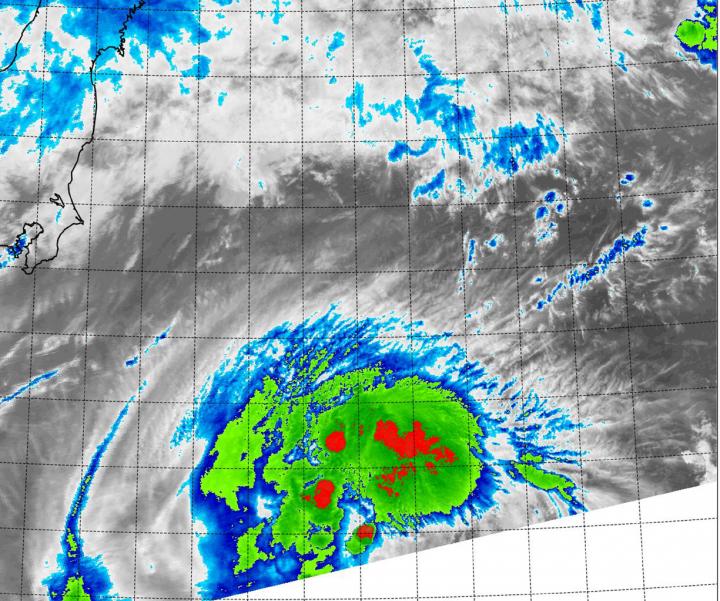NASA's Terra satellite sees Molave regain tropical storm status

On Aug. 11 at 8:05 a.m. EDT the MODIS instrument aboard NASA's Terra satellite captured this infrared image fragmented strong storms (red) in Tropical Storm Molave's northern quadrant. Credits: NASA Goddard MODIS Rapid Response Team
On Aug. 4 at 4:00 UTC (12:00 a.m. EDT) the Moderate Resolution Imaging Spectroradiometer or MODIS instrument aboard NASA's Terra satellite captured an infrared image of a stronger Tropical Storm Molave.
The infrared imagery revealed fragmented, but very cold thunderstorm cloud tops northwest, north and northeast of the center of circulation.
Those cold cloud tops were indicative of stronger convection (rising air that forms thunderstorms).
At 1500 UTC (11 a.m. EDT) on August 11, Molave's maximum sustained winds increased to near 45 knots (51.7 mph/83.3 kph).
It was centered near 32.5 North latitude and 144.5 East longitude, about 292 nautical miles (336 miles/540.8 km) southeast of Yokosuka, Japan.
Molave was moving to the west-northwest at 8 knots (9.2 mph/14.8 kph).
As Molave moves to the northeast, the storm is intensifying.
The Joint Typhoon Warning Center expects Molave to peak at 60 knots (69 mph/111 kph) before becoming extra-tropical southeast of Kamchatka.
Media Contact
All latest news from the category: Earth Sciences
Earth Sciences (also referred to as Geosciences), which deals with basic issues surrounding our planet, plays a vital role in the area of energy and raw materials supply.
Earth Sciences comprises subjects such as geology, geography, geological informatics, paleontology, mineralogy, petrography, crystallography, geophysics, geodesy, glaciology, cartography, photogrammetry, meteorology and seismology, early-warning systems, earthquake research and polar research.
Newest articles

Webb captures top of iconic horsehead nebula in unprecedented detail
NASA’s James Webb Space Telescope has captured the sharpest infrared images to date of a zoomed-in portion of one of the most distinctive objects in our skies, the Horsehead Nebula….

Cost-effective, high-capacity, and cyclable lithium-ion battery cathodes
Charge-recharge cycling of lithium-superrich iron oxide, a cost-effective and high-capacity cathode for new-generation lithium-ion batteries, can be greatly improved by doping with readily available mineral elements. The energy capacity and…

Novel genetic plant regeneration approach
…without the application of phytohormones. Researchers develop a novel plant regeneration approach by modulating the expression of genes that control plant cell differentiation. For ages now, plants have been the…





















